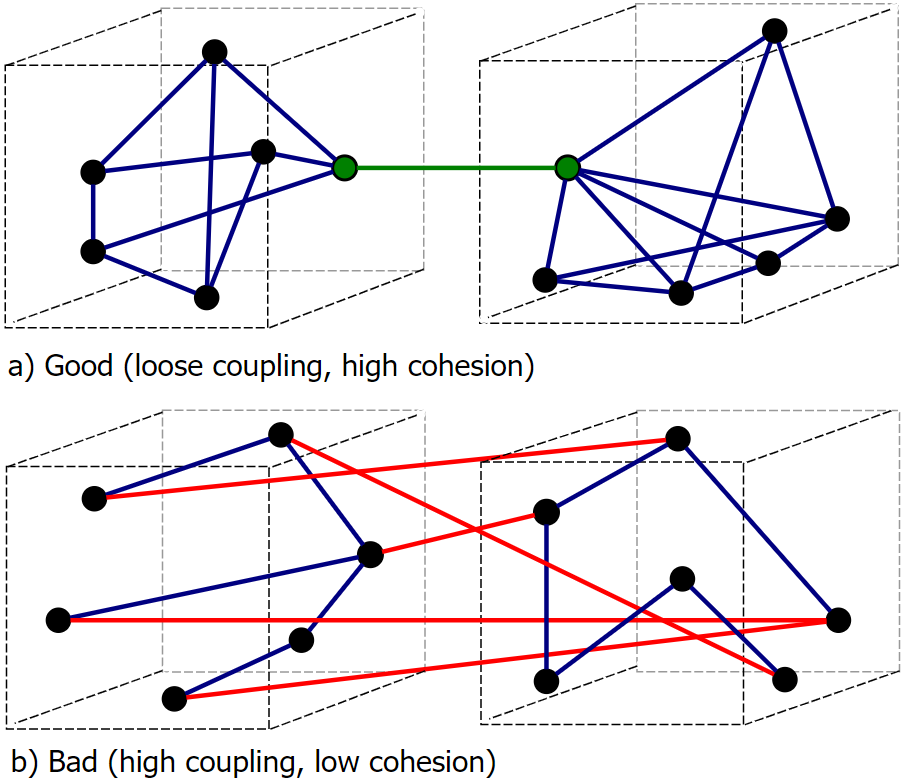Java SE: Coupling and DDD
Coupling/cohesion in modern java and microservices and DDD
📘 Coupling/coherence
Coupling refers to the degree to which one class or module depends on another class or module.
High/tight coupling means that one class or module depends heavily on another class or module, while low/loose coupling means that one class or module has minimal dependencies on other classes or modules.
Coupling refers to the degree of dependence, decoupling, on the other hand, refers to the process of reducing the degree of coupling between different classes or modules in a system. By decoupling classes or modules, you can make the system more modular, scalable, flexible, and maintainable.
Coupling and decoupling are fundamental in modern Java applied to microservices.
1 Key-concept
The importance of decoupling in Java lies in its ability to improve the modularity, flexibility, and maintainability of a system. When classes or modules are highly coupled, changes to one class or module can have a cascading effect on other classes or modules, which can make the system difficult to modify and maintain. By decoupling classes or modules, you can reduce the dependencies between them, which can make the system more modular and easier to modify and maintain.
Additionally, decoupling can help to improve the reusability of classes or modules. When classes or modules are highly coupled, it can be difficult to reuse them in other contexts or situations. By decoupling classes or modules, you can make them more self-contained and independent, which can make them more easily reusable in other contexts.
2 What is the Domain? DDD?
To define domain-driven design, we should first establish what we mean by domain in this context (and in development in general).
The standard dictionary definition of domain is: “A sphere of knowledge or activity.” Drilling down a bit from that, the domain in software engineering commonly refers to the subject area on which the application is intended to apply.
In other words, during application development, the domain is the sphere of knowledge and activity around which the application logic revolves.
Coupling degree in a project is highly related to the project desing stage. Using a Domain-Driven Design strategy can reduce the coupling between the different entities, value objects, domain events, etc…
2.1 Ubiquitous Language
Ubiquitous Language is the term Eric Evans uses in Domain Driven Design for the practice of building up a common, rigorous language between developers and users.
This language should be based on the Domain Model used in the software - hence the need for it to be rigorous, since software doesn’t cope well with ambiguity.
2.2 Extreme Programming (XP)
Extreme Programming (XP) is a software development methodology developed primarily by Kent Beck.
XP was one of the first agile methods, indeed XP was the dominant agile method in the late 90s and early 00s before Scrum became dominant as the noughties passed: XP was the primary catalyst that got attention to agile methods.
2.3 Technical debt
Software systems are prone to the build up of cruft - deficiencies in internal quality that make it harder than it would ideally be to modify and extend the system further.
2.4 Building Blocks
Domain Driven Design also defines several high-level concepts that can be used in conjunction with one another to create and modify domain models:
- Entity
- Value Object
- Domain Event
- Aggregate
- Service
- Repository
- Factories
- Controller
- Test
- Manager
3 Example: CarFactory
Here is an example of decoupling in Java, using a CarFactory class to create different types of cars:
CarFactory.java
public class CarFactory {
// Private constructor to prevent instantiation
private CarFactory() { }
// Factory method for creating cars
public static Car createCar(String type) {
switch (type) {
case "sedan":
return new Sedan("Toyota", "Camry", 2019);
case "hatchback":
return new Hatchback("Honda", "Fit", 2019);
case "suv":
return new SUV("Jeep", "Grand Cherokee", 2019);
default:
throw new IllegalArgumentException("Invalid car type: " + type);
}
}
}In this example, the CarFactory class defines a createCar() method, which is marked as public and static. This method is the factory method, which is responsible for creating objects of the Car type. The createCar() method takes a type parameter, which specifies the type of car to create, and returns an instance of the appropriate concrete class.
By decoupling the CarFactory class from the code that uses the cars, you can make the code that uses the cars more flexible and reusable. For example, you could define a CarDriver class that takes a Car object as a parameter, and uses the Car object to drive the car. Because the CarDriver class doesn’t depend on the CarFactory class, you can use the CarDriver class to drive any type of car, regardless of how the car was created.
Additionally, by decoupling the CarFactory class from the code that uses the cars, you can make the logic for creating the cars more modular and maintainable. For example, if you want to add a new type of car, such as a truck, you can simply add a new Truck class that extends the Car class, and then update the CarFactory class to include logic for creating instances of the Truck class. Because the CarFactory class is decoupled from the code that uses the cars, you don’t have to change any other code in the system in order to add the new car type.
4 Conclusion
Overall, decoupling is an important concept in Java programming, and can help to improve the modularity, flexibility, and maintainability of a system.
By reducing the dependencies between classes or modules, you can make the system more modular and easier to modify and maintain, and you can improve the reusability of individual classes or modules.
